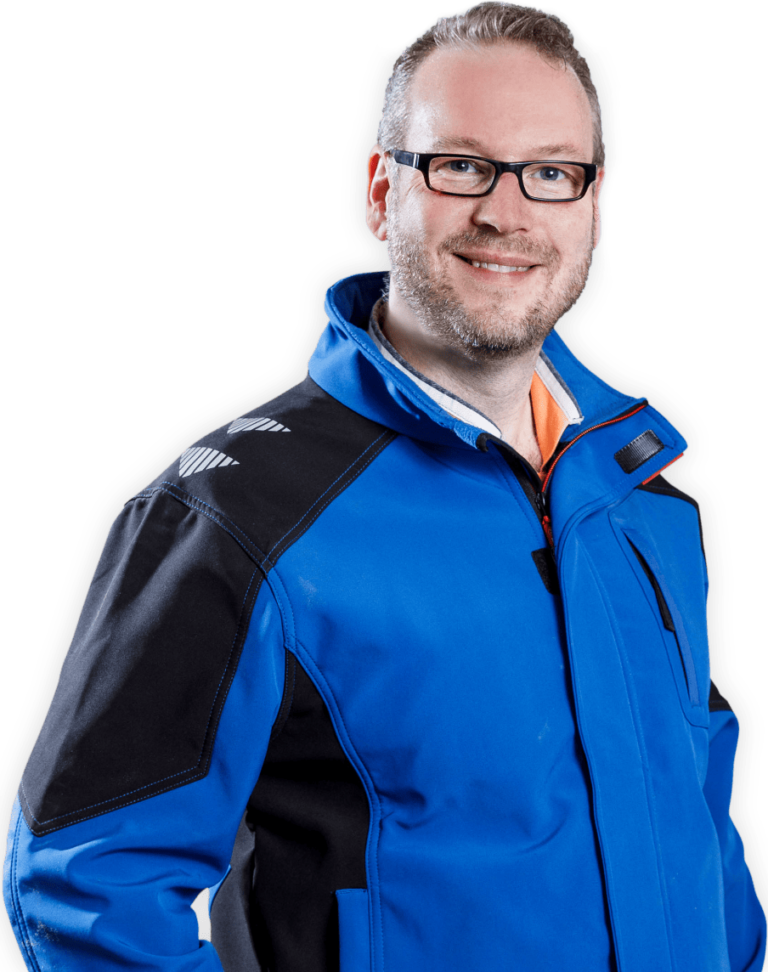Waterproof basement
Since 2010 Haustrocknung.ch GmbH has been sealing basements throughout Switzerland with the electrophysical DRYMAT® system. In this guide, we provide an overview of the advantages and disadvantages of the different processes.
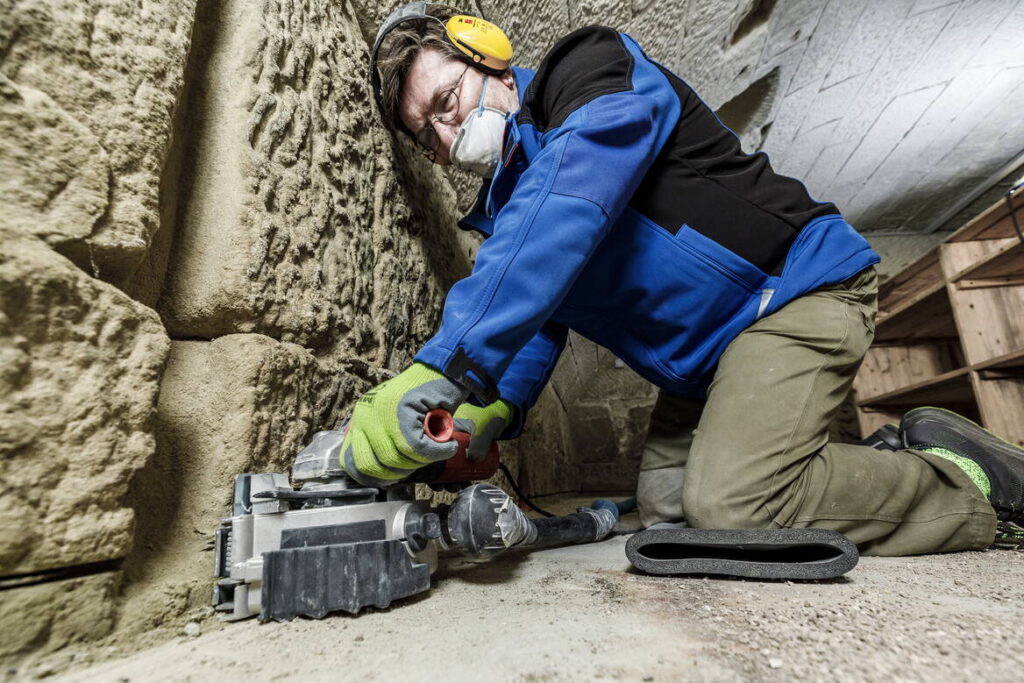
How to waterproof the basement?
- How do damp basement walls?
- What requirements should meet a basement waterproofing?
- What are the sealing methods?
- What are the risks associated with manual waterproofing methods?
- What are the advantages and disadvantages of electrophysical sealing?
- Why is electrophysical sealing controversial in practice?
- What are the arguments against building dryers?
- How much does basement waterproofing cost in Switzerland?
- Conclusion
Core statements
- For effective waterproofing, the causes of moisture must first be identified. The most common causes are defective installations, damage to the building envelope, pressing moisture sources or capillary rising damp in the walls. Often, several causes overlap.
- Optimal basement waterproofing mitigates or eliminates the cause of moisture, keeps the entire building structure permanently dry.
- With the horizontal barrier, the area below the barrier remains damp; the inside vertical barrier cannot protect the wall outside and below from moisture penetration. With the outside vertical barrier, the wall is also not protected from moisture below.
- Electrophysical wall dehumidification works actively against moisture and dries the entire building structure down to the basement floor. However, the method alone is not effective in the case of pressing moisture and damage to the building envelope.
1. How do damp basement walls?
The most common causes of damp basement walls are
- Condensation
- Defective installations and damage to the building envelope
- Rising damp in the basement wall
- Pressing water
In most cases, several causes of moisture overlap. Therefore, it is worthwhile to have the building inspected by experienced building experts. In the following sections, we will go into detail about the damage mechanisms of the individual causes.
When moist air meets a cool surface, condensation occurs, such as on the outside of a cool glass bottle. In the case of buildings, this leads to consequential damage over time, such as mold growth, musty odors and decomposition of the building fabric. Reasons for high humidity are often incorrect ventilation, water vapor from showering, cooking or drying laundry. Because warm air can absorb more moisture than cold air, airing should be done at the coolest time of day, if possible.
Poor installations on the house often lead to moisture damage. Examples of such installations are flat roofs, gutters, downspouts, cisterns, rain barrels; the condition of bricks, stones, mortar, plaster, wall bases, weatherproof paints, moisture barrier coatings and silicone joints; weak points in the building envelope, such as cracks in masonry and coverings; constructions that conduct water to the masonry, including leaking windows and doors, heat exchangers or exhaust vents of vents; chimneys and rain deflector plates.
The phenomenon of capillary rising damp in the building fabric occurs because the wall is naturally negatively charged. Thus, the building substance absorbs moisture into itself, much like a sponge. In the three causes of moisture discussed, the real problem is not the leakage of the basement wall, but either the habits of the people in the house, defects in the installations on the house or the physical properties of the building substance.
In other words, basement waterproofing is usually not about «waterproofing» in the first place, but about identifying and eliminating the causes that lead to moisture in the building structure. Therefore, you should not think about appropriate methods of basement waterproofing until you have clearly identified the causes of moisture. To do this, it is worthwhile to consult building experts on moisture.
In rare cases, an oppressive moisture source may be the cause of basement wall moisture penetration. Oppressive moisture includes slope, strata or periodically high groundwater, as well as springs or other water veins near the building. Pressing moisture usually means that the building was constructed in an unfavorable location. However, heavy moisture penetration is not yet an indication of pressing water.
2. What requirements should meet a basement waterproofing?
An optimal basement waterproofing
- Eliminates or mitigates the causes of moisture
- Keeps the building fabric completely and permanently dry
- Interferes as little as possible with the building fabric
Deep interventions in the building fabric involve static risks and the danger of consequential damage, such as cracks or stress redistribution. They should therefore only be carried out, especially in old buildings, if there is no gentler alternative (cf. Methods of waterproofing under 3.).
Hermetic sealing of the basement is fundamentally undesirable, as the wall can then no longer «breathe». This usually leads to consequential damage that does not necessarily have to be visible. For these reasons, impermeable barrier layers should only be implemented if all other methods fail to achieve the desired result. This applies in particular to the case of an oppressive source of moisture (cf. Causes under 1.).
3. What are the sealing methods?
To seal leaking basement walls, there are basically three options:
- Vertical barrier: A large-area waterproof barrier layer is applied to the outside or inside of the wall, such as a bituminous coating or a slurry plaster.
- Horizontal barrier: at a certain height of the wall is installed waterproof barrier layer, which crosses the entire diameter of the wall.
- Electrophysical barrier: By installing electrodes, a positive electrical potential is induced in the wall, which protects the wall from moisture penetration.
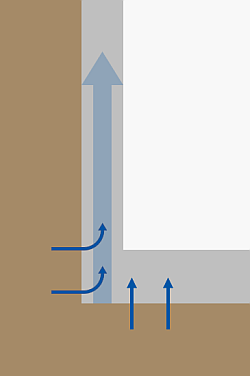
Rising damp
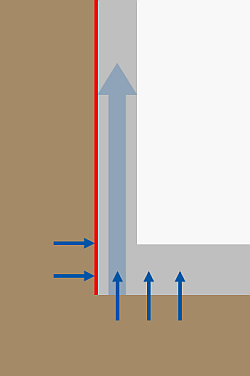
Principle of the vertical barrier
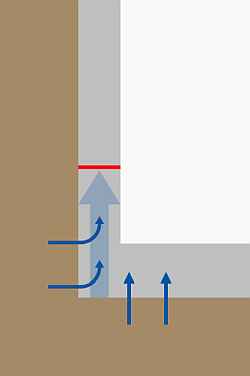
Principle of the horizontal barrier
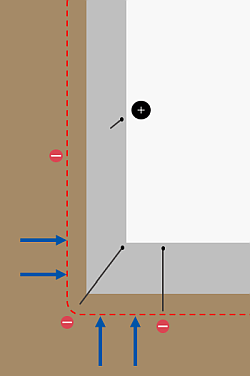
Electrophysical barrier
While horizontal and vertical barriers are easy to understand in principle, electrophysical waterproofing requires a more detailed explanation: When moisture rises, water can rise up the capillaries (narrow «tubes», crevices or cavities) of the building material. This effect is also called the «capillary effect», or «suction tension», and occurs naturally because the building material has a negative electrical charge.
As part of the electrophysical sealing process, a positive electrical potential is induced in the wall. «Electroosmosis» occurs: the capillary effect is neutralized. As a result, no new moisture can rise or penetrate the building fabric. The residual moisture evaporates over time, the wall becomes permanently dry down to the cellar floor. Electroosmosis also copes with a strong moisture load - in the case of pressing water or if the building envelope is damaged by cracks, it is only able to dry the penetrating moisture faster.
4. What are the risks associated with manual sealing methods?

Rising damp

Principle of the vertical barrier

Principle of the horizontal barrier

Electrophysical barrier
Optimal basement waterproofing firstly defuses or eliminates the moisture problem, secondly keeps the entire building structure permanently dry, and thirdly can be implemented in a minimally invasive manner. How well do vertical and horizontal barriers meet these three requirements?
Horizontal and vertical barriers solve the moisture problem only inadequately: With the horizontal barrier, the area below the barrier, such as the basement floor, remains damp; the inside vertical barrier cannot protect the wall outside and below from penetrating moisture. With the outside vertical barrier, the wall below is also not protected from moisture.
The external vertical barrier is also very complex and expensive to implement, especially since the basement wall must be completely exposed. Horizontal barriers are less complex in comparison, but require deep structural intervention in the masonry, which can be structurally tricky. It is better to refrain from this, especially in old buildings.
5. What are the advantages and disadvantages of electrophysical sealing?
Electrophysical basement dehumidification with the DRYMAT® system works actively against moisture and can permanently dry out both basement walls and basement floors even under high moisture loads. Thanks to the electrical potential, the dehumidified building fabric does not absorb any new moisture, but remains permanently protected against moisture (cf. Functionality in detail under 3.).
Thanks to its active effect, electrophysical sealing requires only minimal structural intervention and thus leads to considerable cost savings compared to vertical and horizontal barrier methods. The electricity costs for maintaining the electrical potential amount to approximately CHF 50 per year. This consumption is due to the control unit. No current flows in the wall and there is no exposure to electrosmog.
Moreover, electrophysical drying with DRYMAT® is risk-free for people and the environment and has no influence on the building's statics and is suitable for the protection of historical monuments. The DRYMAT® system works according to scientifically recognized principles and is certified according to Ö-Norm B 3355-2. Last but not least, you will receive from us a 10-year warranty on the control unit and another 10 years from the ISO certified manufacturer as well as a 2-year warranty on the electrode installation according to SIA. More about our offer for basement waterproofing

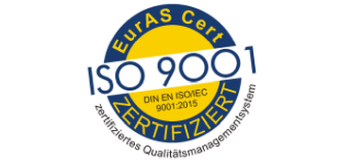
6. Why is electrophysical sealing controversial in practice?
There are several suppliers:inside and systems for electrophysical sealing on the market. Some of them offer control devices that build up a positive electrical potential exclusively via radio waves. In our experience, radio-only systems can only dehumidify your walls and floors but cannot dry out an entire building.
We represent DRYMAT® exclusively in Switzerland. The manufacturer is ISO 9001 certified for both the control unit and the application. The DRYMAT® system builds up the electrical potential via titanium electrodes installed in the wall. We have been using this system successfully for over 10 years and are therefore able to give a promise of success.

Installation of electrophysical basement waterproofing with the DRYMAT® system
7. What is the argument against building dryers?
Powerful building dryers are primarily suitable for drying buildings after water damage or during the construction phase. In the case of a moisture problem, however, where the wall absorbs moisture via the capillary suction tension of the building material, they can have a counterproductive effect: In this case, the building dryers actually lead to an increase in hygroscopy (wall can absorb more moisture from the air), while the cause of the dampness remains.
As a result, even more moisture gets into the wall in the medium term. Mineral salts also enter the masonry with the moisture. These dissolved salts can crystallize. This results in an increase in volume, which in the long term leads to damage to the building fabric. Due to the salinization, the masonry then absorbs even more moisture.
8. How much does basement waterproofing cost in switzerland?
Electrophysical basement waterproofing with the DRYMAT® system costs about CHF 15,000 to 20,000 for a single-family house with a floor area of 60 m2. This amount includes all work steps including analysis, installation and follow-up measurement 18 months after installation. Added to this are the operating costs of about CHF 50 per year. Maintenance is not required.
In comparison, the costs for draining the same building with a drainage system amount to about CHF 45,000 to 60,000. The expenses for the earthworks are particularly significant. A waterproofing alone causes costs of about CHF 350 per square meter.
9. Conclusion
For successful basement waterproofing, the causes of the moisture must first be carefully determined. A specialist should be consulted here, as there are often several causes of dampness that can overlap. The most common causes are condensation, faulty installations on the structure, damage to the building envelope and rising damp within the wall.
If the problem is rising damp in the masonry without pressing water and without damage to the building envelope, electrophysical basement waterproofing is the most effective and cost-efficient solution because it actively combats moisture and can be installed in a minimally invasive manner. In contrast to electroosmosis, parts of the building structure remain damp during horizontal and vertical waterproofing.
We are the exclusive representative of DRYMAT® in Switzerland. Our system comes with a guarantee of success, because both the system and the procedure for its application are Ö-Norm B 3355-2 certified.
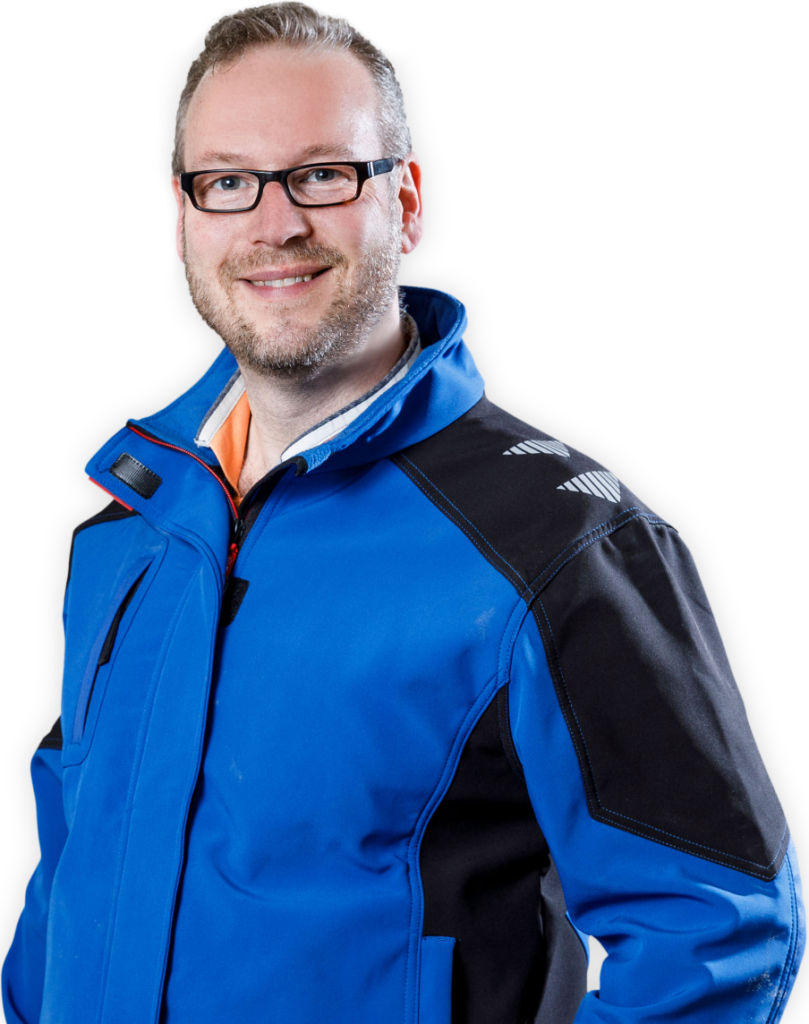
Contact us without obligation
Do you have any further questions or may we prepare an offer for you?
Get in touch with us without obligation. We look forward to your inquiry!
Get in touch with us without obligation. We look forward to your inquiry!
Tobias Bayer
Managing Director
